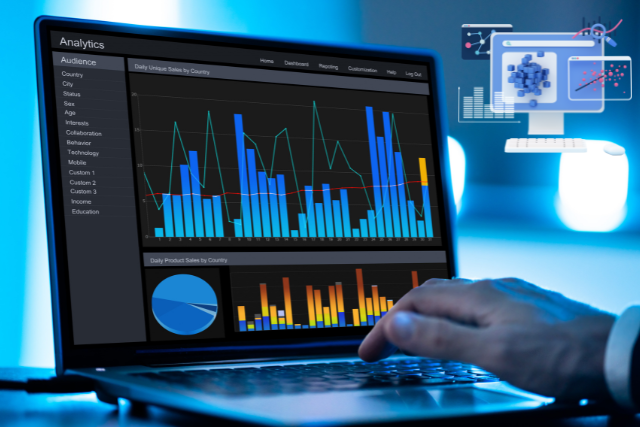Running an e-commerce business is all about staying ahead of the curve. One of the best ways to do that is by using predictive analytics. This powerful tool helps you understand your customers better, anticipate sales trends, and make smarter decisions. Whether it’s managing inventory or planning marketing strategies, predictive analytics can help you achieve more growth with less guesswork.
Let’s explore how predictive analytics works and how you can use it to boost your e-commerce sales.
Table of Contents
What is Predictive Analytics?
Predictive analytics is a technique that uses past data to predict future outcomes. For e-commerce, this means analyzing your past sales, customer behaviour, and market trends to anticipate what might happen next. Instead of reacting to changes after they happen, you can stay ahead by making data-driven decisions.
For example, by looking at your historical sales data, you can predict when demand for a product will spike or which items are likely to sell more during a certain season. This allows you to adjust your inventory, improve marketing efforts, and increase sales.
How to Use Predictive Analytics in E-Commerce
Let’s break down the key steps you need to take to start using predictive analytics in your e-commerce business:
1. Collecting the Right Data
The first step is collecting data. This can come from various sources, including:
- Sales History: Your previous sales data helps you identify patterns.
- Customer Behavior: Tracking how customers browse and purchase can reveal their preferences.
- Market Trends: Keeping an eye on the market gives you a better understanding of external factors influencing your sales.
You can use tools like Google Analytics to collect customer data and track sales performance.
2. Analyzing the Data
Once you’ve collected the data, the next step is to analyze it. Tools like Tableau can help you turn raw data into easy-to-understand visuals. These visuals show trends, like which products are popular or which months typically have higher sales.
Analyzing this data will help you spot patterns that aren’t always obvious. For instance, you might notice that certain products always sell better during the holidays or that your customers prefer buying on weekends.
3. Building Predictive Models
With the data analyzed, you can now build predictive models to forecast what will happen next. These models use different techniques like regression analysis or machine learning to predict future sales trends, customer demand, or the success of marketing campaigns.
If you’re not familiar with building models, don’t worry. Platforms like IBM Watson Analytics use artificial intelligence to help you build predictive models without needing a deep understanding of coding.
4. Implementing Insights
Once you have predictions, the next step is putting those insights into action. If you predict a spike in demand for a certain product, you can stock up on inventory ahead of time. If your data shows that certain customers respond well to discounts, you can target them with personalized offers.
Using predictive analytics allows you to take actions that are more likely to drive results.
Benefits of Using Predictive Analytics
Using predictive analytics has many benefits for e-commerce businesses. Here are a few key ways it can improve your operations:
1. Better Decision-Making
With predictive analytics, your decisions are based on real data, not guesswork. You’ll know which products are likely to sell when demand rises and how customers respond to certain marketing efforts. This helps you make better, more informed decisions.
For example, by using Google Analytics, you can track which products have the highest demand and use that information to plan future stock levels.
2. Improved Inventory Management
One of the biggest challenges in e-commerce is managing inventory. Predictive analytics helps you forecast demand so you can avoid overstocking or understocking. This means fewer items sitting unsold in your warehouse and fewer missed sales due to out-of-stock products.
Tools like TradeGecko can help you manage inventory more efficiently by integrating predictive analytics into your stock management system.
3. Targeted Marketing Campaigns
Predictive analytics can also improve your marketing efforts. By analyzing customer behaviour and purchase history, you can send more personalized offers that resonate with each customer. This leads to higher engagement and more sales.
Platforms like Mailchimp allow you to use customer data to create targeted marketing campaigns, ensuring that each message you send is relevant to the recipient.
Tools for Predictive Analytics
Here are some useful tools you can use to start leveraging predictive analytics for your e-commerce business:
- Google Analytics: Helps you track website traffic, customer behaviour, and sales data.
- Tableau: A data visualization tool that makes it easy to spot trends and patterns.
- IBM Watson Analytics: Uses AI to help you analyze data and build predictive models.
- Microsoft Power BI: A business analytics tool that integrates with other Microsoft products for seamless data analysis.
- Price2Spy: A tool that helps you track competitor pricing and adjust your pricing strategies accordingly.
How to Use Historical Sales Data
Historical sales data is one of the most valuable resources for e-commerce businesses. By analyzing past sales trends, you can make better predictions about future demand.
Here are a few key areas to focus on:
- Seasonal Trends: Identify patterns in your sales that happen during certain times of the year, such as holiday shopping spikes or slow periods in the summer.
- Top-Selling Products: Look at which products consistently perform well and plan your inventory around these.
- Customer Preferences: Use customer data to understand which types of products or offers your audience prefers.
Using tools like Google Analytics or Tableau can help you dive deeper into your historical data and make more accurate forecasts.
Predictive Models and Forecasting Techniques
There are several forecasting techniques you can use to predict future sales in e-commerce. Here are a few common ones:
- Time-Series Forecasting: Uses past data to predict future sales trends over time. It’s especially useful for businesses with seasonal sales cycles.
- Regression Analysis: Helps you understand the relationship between different factors, like how marketing spending influences sales.
- Machine Learning Models: These advanced models use algorithms to learn from data, making them more accurate over time as they process more information.
If you’re new to predictive modelling, platforms like IBM Watson Analytics can help simplify the process.
Measuring Success and Making Adjustments
Once you start using predictive analytics, it’s important to check the results and make adjustments as needed regularly. Compare your predicted outcomes with actual sales data to see if your forecasts were accurate.
If you find discrepancies, refine your models. The more you fine-tune them, the more accurate they’ll become over time.
Tools like Google Analytics and Tableau can help you track your performance and identify areas for improvement.
FAQs
What Data is Needed for Predictive Analytics?
For predictive analytics, you need historical sales data, customer behaviour data, and market trends. Collecting this information helps you build models that predict future sales and customer actions.
How Often Should I Update Predictions?
It’s a good idea to update your predictions regularly, such as monthly or quarterly. This keeps your forecasts accurate and helps you adapt to any changes in customer behaviour or market conditions.
Can Predictive Analytics Help with Inventory Management?
Yes, predictive analytics can help optimize your inventory management by forecasting demand. This allows you to stock up on products that are likely to sell and avoid overstocking items that won’t move.
What Tools Should I Use for Predictive Analytics?
Tools like Google Analytics, Tableau, and IBM Watson Analytics are great for collecting data, building models, and visualizing trends.
How Do I Use Predictive Analytics for Marketing?
You can use predictive analytics to create targeted marketing campaigns based on customer behaviour and preferences. Platforms like Mailchimp allow you to segment your audience and send personalized messages that are more likely to lead to sales.
How Do I Improve My Predictive Models?
To improve your predictive models, make sure you’re using high-quality data and regularly test your models against actual outcomes. The more you fine-tune your models, the more accurate they will become.
Conclusion
Predictive analytics is a game-changer for e-commerce businesses. By analyzing your historical data, forecasting future trends, and making data-driven decisions, you can stay ahead of your competition and boost your sales. Start with the right tools like Google Analytics and Tableau, and watch your e-commerce business thrive with more accurate predictions and smarter strategies.







